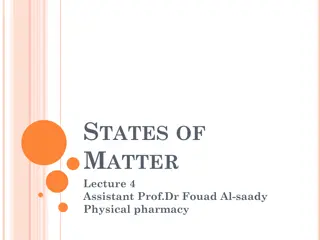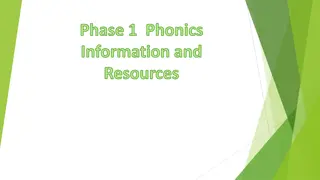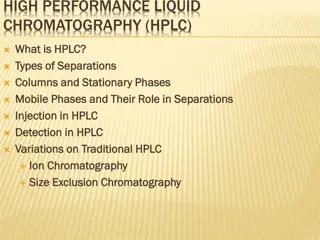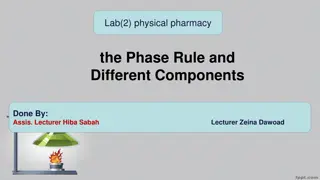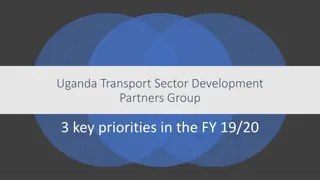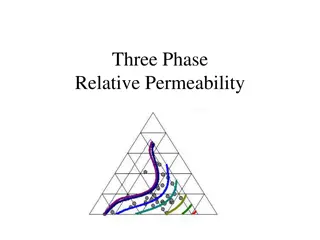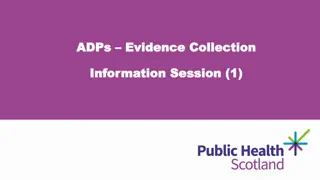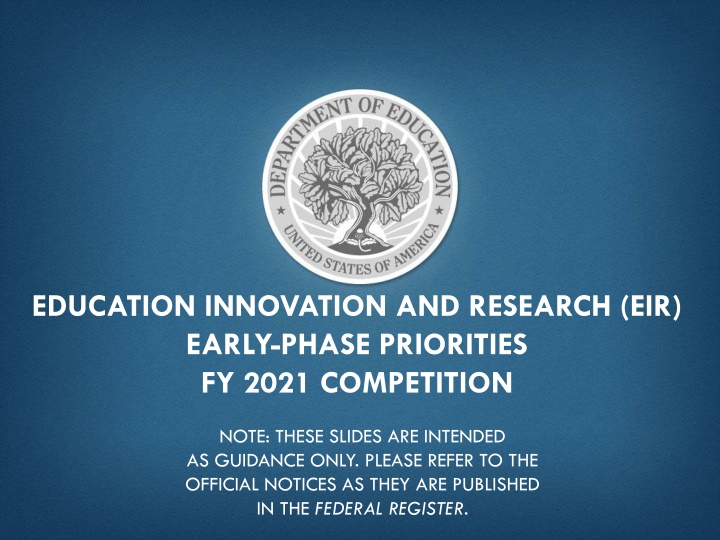
Innovation and Research Priorities for Education - FY 2021 Competition
Explore the absolute priorities and logic model in early-phase education innovation and research projects for the FY 2021 competition. Understand the significance of demonstrating rationale, field-initiated innovations, and fostering knowledge to improve student outcomes. Access resources and guidance for effective program planning and evaluation.
Download Presentation

Please find below an Image/Link to download the presentation.
The content on the website is provided AS IS for your information and personal use only. It may not be sold, licensed, or shared on other websites without obtaining consent from the author. If you encounter any issues during the download, it is possible that the publisher has removed the file from their server.
You are allowed to download the files provided on this website for personal or commercial use, subject to the condition that they are used lawfully. All files are the property of their respective owners.
The content on the website is provided AS IS for your information and personal use only. It may not be sold, licensed, or shared on other websites without obtaining consent from the author.
E N D
Presentation Transcript
EDUCATION INNOVATION AND RESEARCH (EIR) EARLY-PHASE PRIORITIES FY 2021 COMPETITION NOTE: THESE SLIDES ARE INTENDED AS GUIDANCE ONLY. PLEASE REFER TO THE OFFICIAL NOTICES AS THEY ARE PUBLISHED IN THE FEDERAL REGISTER.
ABSOLUTE PRIORITIES Absolute Priority (AP) 1: Demonstrates a Rationale: All Early-phase applicants must address this evidence priority. Demonstrates a rationale means a key project component included in the project s logic model is informed by research or evaluation findings that suggest the project component is likely to improve relevant outcomes. 2
WHAT IS A LOGIC MODEL? Logic model (also referred to as a theory of action) means a framework that identifies key project components of the proposed project (i.e., the active ingredients that are hypothesized to be critical to achieving the relevant outcomes) and describes the theoretical and operational relationships among the key project components and relevant outcomes. 3
SAMPLE LOGIC MODEL Source: REL Pacific see link on next slide. 4
LOGIC MODEL RESOURCES Education Logic Model (ELM) Application (REL Pacific) Logic models: A tool for effective program planning, collaboration, and monitoring (REL Pacific) Logic models: A tool for designing and monitoring program evaluations (REL Pacific) Logic models for program design, implementation, and evaluation: Workshop toolkit (REL Northeast and Islands) 5
ABSOLUTE PRIORITIES (CONT.) Early-phase applicants must select one of the absolute priorities listed below. Applicants must clearly indicate which one in their abstract and project narrative. Absolute Priority 2: Field-Initiated Innovations General Absolute Priority 3: Field-Initiated Innovations Science, Technology, Engineering, or Mathematics (STEM) Absolute Priority 4: Field-Initiated Innovations Fostering Knowledge and Promoting the Development of Skills That Prepare Students To Be Informed, Thoughtful, and Productive Individuals and Citizens The priority promotes social and emotional learning (SEL). 6
EARLY-PHASE ABSOLUTE PRIORITY 2 Field-initiated innovations General Projects that are designed to create, develop, implement, replicate, or take to scale entrepreneurial, evidence-based, field-initiated innovations to improve student achievement and attainment for high-need students. 7
EARLY-PHASE ABSOLUTE PRIORITY 3 Field-initiated innovations -- Promoting STEM education, with particular focus on computer science Under the priority, we provide funding to projects that are designed to: 1. Create, develop, implement, replicate, or take to scale entrepreneurial, evidence-based, field-initiated innovations to improve student achievement and attainment for high-need students, and; 2. Improve student achievement or other educational outcomes in one or more of the following areas: science, technology, engineering, math, or computer science (as defined in the notice). 8
EARLY-PHASE ABSOLUTE PRIORITY 4 Field-initiated innovations -- Fostering Knowledge and Promoting the Development of Skills That Prepare Students To Be Informed, Thoughtful, and Productive Individuals and Citizens Under the priority, we provide funding to projects that are designed to: 1. Create, develop, implement, replicate, or take to scale entrepreneurial, evidence-based, field-initiated innovations to improve student achievement and attainment for high-need students; and 9
EARLY-PHASE ABSOLUTE PRIORITY 4 (CONT.) Field-initiated innovations -- Fostering Knowledge and Promoting the Development of Skills That Prepare Students To Be Informed, Thoughtful, and Productive Individuals and Citizens Under the priority, we provide funding to projects that are designed to: 2. Improve student academic performance and better prepare students for employment, responsible citizenship, and fulfilling lives, including by preparing children or students to do one or more of the following: (a) Develop positive personal relationships with others. (b) Develop determination, perseverance, and the ability to overcome obstacles. (c) Develop self-esteem through perseverance and earned success. (d) Develop problem-solving skills. (e) Develop self-regulation in order to work toward long-term goals. 10
COMPETITIVE PREFERENCE PRIORITIES Early-phase applicants may address multiple competitive preference priorities (CPPs). Competitive Preference Priority 1: Computer Science Applicants have the option of addressing this CPP if they apply under Absolute Priority 3: STEM. Competitive Preference Priority 2: Innovative Approaches to Addressing the Impact of COVID-19 on Underserved Students and Educators Competitive Preference Priority 3: Promoting Equity and Adequacy in Student Access to Educational Resources and Opportunities Applicants have the option of addressing this CPP, regardless of which absolute priority they submit under. Applicants have the option of addressing this CPP, regardless of which absolute priority they submit under. 11
COMPETITIVE PREFERENCE PRIORITY 1 Computer Science: Projects designed to improve student achievement or other educational outcomes in computer science. These projects must address expanding access to and participation in rigorous computer science coursework for traditionally underrepresented students such as racial or ethnic minorities, women, students in communities served by rural local educational agencies (as defined in this notice), children or students with disabilities (as defined in this notice), or low- income individuals (as defined under section 312(g) of the Higher Education Act of 1965, as amended). 12
COMPETITIVE PREFERENCE PRIORITY 2 Innovative Approaches to Addressing the Impact of COVID- 19 on Underserved Students and Educators: Projects designed to address the needs of underserved students and educators most impacted by COVID-19 through (a) Engaging in two-way, mutually respectful collaboration with key stakeholders, such as families, caretakers, students, educators (including teachers, school leaders and other school staff), and community leaders (including individuals from diverse cultural, linguistic, and socioeconomic backgrounds), to assess and understand students social, emotional, physical and mental health, and academic needs, in light of historical educational inequities and the impact of the COVID-19 pandemic; and 13
COMPETITIVE PREFERENCE PRIORITY 2 (CONT.) (b) Developing and implementing strategies to address those needs through one or more of the following: (1) Re-engaging students (and their families) and strengthening relationships between educators, students, and families. (2) Supporting district- and school-wide use of personalized learning (as defined in this notice). (3) Utilizing multi-tier system of supports (as defined in this notice) and universal design for learning (as defined in this notice). (4) Providing educators with professional development (as defined in this notice) and resources to use trauma-informed practices. 14
COMPETITIVE PREFERENCE PRIORITY 2 (CONT.) (5) Creating or supporting equitable and inclusive learning environments in schools. (6) Ensuring students have access to additional specialized instructional support personnel (as defined in this notice) during their school day, at their school site. (7) Finding and supporting students experiencing homelessness, including those not attending school during the pandemic. (8) Providing additional supports to educators to address their mental health and well-being and instructional practice needs. 15
COMPETITIVE PREFERENCE PRIORITY 2 (CONT.) (9) Providing evidence-based supports and educational opportunities to accelerate grade-level student learning (especially for underserved students) through in-class learning and additional instructional practice, including those supported by technology in ways that do not contribute to tracking or remediation, which may include one or both of the following: (i) High-quality tutoring (as defined in this notice), summer learning and enrichment, or opportunities for high-quality expanded learning time (as defined in this notice) as well as implementation of embedded, high-quality formative assessment to support personalization. (ii) Providing targeted supports for high school students to prepare for post-secondary education transition and success. 16
COMPETITIVE PREFERENCE PRIORITY 3 Promoting Equity and Adequacy in Student Access to Educational Resources and Opportunities: Projects designed to promote equity in access to critical resources for underserved students in prekindergarten through grade 12 through one or more of the following: (a) Addressing inequities in access to fully certified, experienced, and effective teachers through one or more of the following activities: (1) Improving the preparation, recruitment, early career support, and development of teachers in high-need or hard- to-staff schools, including strategies that improve teacher diversity. (2) Reforming hiring, compensation, and advancement systems. 17
COMPETITIVE PREFERENCE PRIORITY 3 (3) Improving the retention of fully certified (including teachers certified in the area they are assigned to teach), experienced, and effective teachers in districts, schools, and classrooms serving high concentrations of underserved students through one or more of the following activities: (i) Providing comprehensive, high-retention pathways into the profession. (ii) Creating or enhancing opportunities for teachers professional growth and leadership opportunities. (iii) Delivering collaborative, job-embedded, and sustained professional development. (iv) Improving workplace conditions to create opportunities for successful teaching and learning, including through inclusive and culturally affirming working environments. 18
COMPETITIVE PREFERENCE PRIORITY 3 (b) Addressing inequities in access to and success in rigorous, engaging, and culturally and linguistically responsive teaching and learning environments that prepare students for college and career through one or both of the following activities: (1) Increasing access to and success in middle school courses that are foundational to advanced coursework in high school; advanced courses and programs, including Advanced Placement, International Baccalaureate, high-quality dual or concurrent enrollment (as defined in this notice), and high-quality early college high school (as defined in this notice), programs; high- quality STEM programs; or high-quality career and technical education pathways that are integrated into the curriculum. (2) Developing, and expanding access to, programs designed to provide a well-rounded education (as defined in this notice). 19
COMPETITIVE PREFERENCE PRIORITY 3 (c) Addressing bias (e.g., implicit and explicit) and creating inclusive, supportive learning environments. (d) Involving diverse stakeholders to include students, families, caretakers, educators (including teachers, school leaders, and other staff), and community leaders in State and local education decisions. (e) Identifying and addressing, in collaboration with students, families, and educators, policies that result in the disproportionate use of exclusionary discipline through data collection and analysis (including school climate surveys) disaggregated by race, sex, English learner, disability status, gender-identity, and sexual orientation, in compliance with 20 U.S.C. 1232h and 34 CFR part 98, and other important variables. 20
COMPETITIVE PREFERENCE PRIORITY 3 (f) Identifying and addressing issues of equity in access to and the use of innovative tools, rigorous content, and effective teaching and learning practices, including by providing job- embedded professional development to educators on strategies for equitably integrating educational technology in ways that elevate student engagement beyond passive use and over- reliance on drill-and-practice to a more robust, creative, and playful medium. (g) Addressing policies, practices, and procedures that contribute to significant disproportionality in special education or programs for English learners based on race or ethnicity. (h) Improving the quality of educational programs in juvenile justice facilities (such as detention facilities and secure and non- secure placements) or supporting re-entry after release, by linking youth to education or job training programs. 21
EXAMPLES OF APPLICANT-SELECTED EARLY-PHASE PRIORITIES AP1: Evidence AP2: General AP3: STEM CPP1: Computer Science AP4: SEL CPP2: COVID CPP3: Equity Example 1 X X X Example 2 X X X Example 3 X X X Example 4 X X X X X Example 5 X X X Example 6 X X 22






